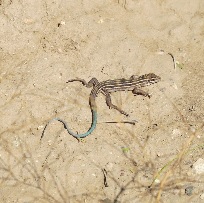Desert Grassland Whiptail (Aspidoscelis uniparens)
Description: The desert grassland whiptail lizard is a relatively small reptile, whose size ranges from 2¾ inches (6.9 cm) to 5¼ inches. Desert grassland whiptails are very long and slim, with a thin tail that is longer than their body length. Their distinct identifying feature are the six yellowish lines that run the length of their body. The majority of the whiptail's body tends to be an olive or brown colour that fades to a faint blue or gray on their tail. Comparatively, an adolescent's tail is a very bright and vibrant blue. Their bodies are lined with small coarse scales, which gradually get larger as they approach the tail. The scales on their bellies are much larger in size and are much smoother as well.
Habitat: The desert grassland whiptail is mostly found in the deserts of southern to central Arizona and along the Rio Grande river in New Mexico. It is also found in the deserts of northern Mexico. A. uniparens is commonly found in low valleys, grasslands, and slight slopes. Some have argued that the species' range is expanding due to overgrazing. A. uniparens are scarce in developed areas, especially where homeowners keep livestock.
Range: The range includes Arizona, New Mexico, extreme western Texas, and adjacent northern Mexico, southward into central Chihuahua.
Found in these States:
AZ |
NM |
TX
Diet: For the most part, the Desert grassland whiptail digs for termites, Queen ants, beetles, and unidentified insects. A smaller portion of their diet includes prey found above ground such as grasshoppers and butterflies.
Reproduction: All desert grassland whiptail lizards are female. Their reproduction process does not need male fertilization, although researchers observed pseudo-copulation that promotes fertilization during ovulation. This process involves the alternation between male-typical and female-typical sexual behaviours, driven by progesterone, in both lizards; corresponding to the state of their partner. The lizards reproduce by parthenogenesis and are clones of their mother. Under normal reproductive processes, a species has each chromosome pair separated, copied, and paired back with its counterpart. The desert grassland whiptail lizard, however, has chromosome triplets where each triplet is paired with its copy rather than its counterparts. This reproductive method enables the asexual desert grassland whiptail lizard to have a genetic diversity previously thought to have been unique to sexually reproductive species.
The lizards were a result from a cross breed of two bisexual species, Little Striped Whiptail - (Aspidoscelis inornata) and Canyon Spotted Whiptail - (Aspidoscelis burti). This then produced a diploid unisexual, which backcrossed to inornata and produced triploid uniparens.
Status: Listed as Least Concern in view of the relatively stable large extent of occurrence, area of occupancy, number of subpopulations, and population size. No major threats are known.
»» Kingdom: Animalia - Animals
»» Phylum: Chordata - Chordates
»» Subphylum: Vertebrata - Vertebrates
»» Class: Reptilia - Reptiles
»» Order: Squamata - Lizards
»» Family: Teiidae - Whiptails & Racerunner Lizards
»» Genus: Aspidoscelis
»» Species: Aspidoscelis uniparens - Desert Grassland Whiptail
»» Subspecies: None
This article uses material from the Wikipedia article "Desert Grassland Whiptail", which is released under the Creative Commons Attribution-Share-Alike License 3.0. Content may have been omitted from the original, but no content has been changed or extended.
|








